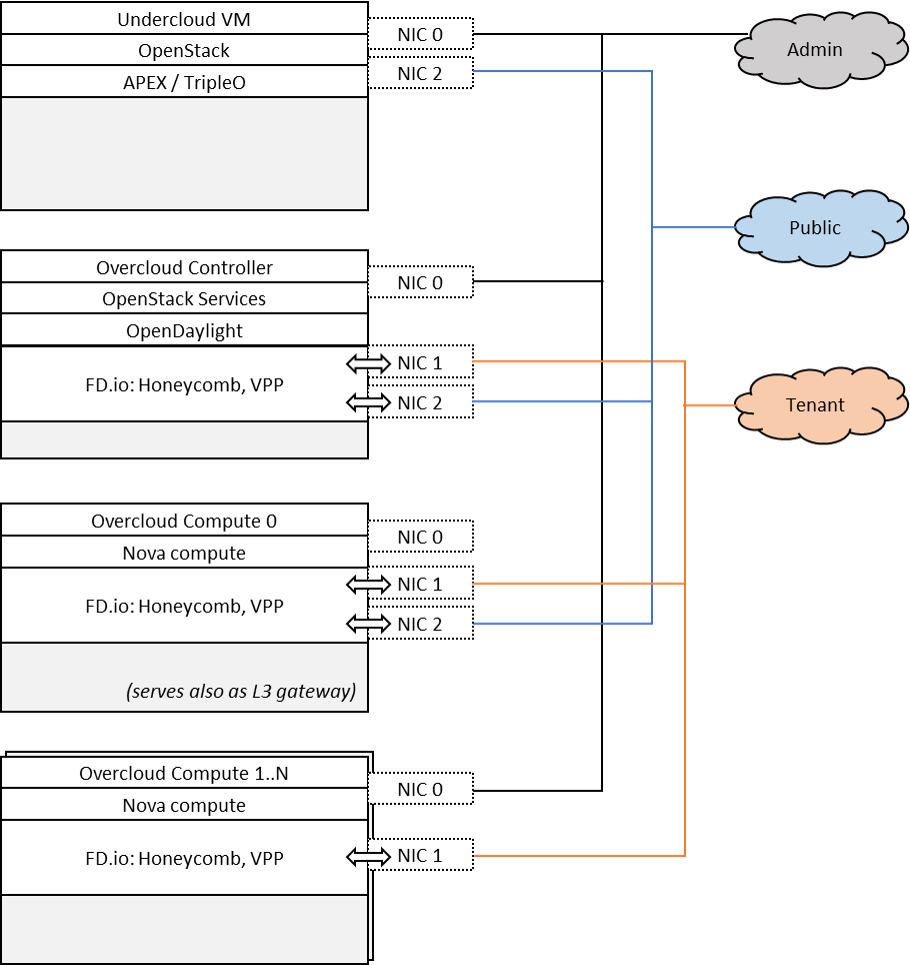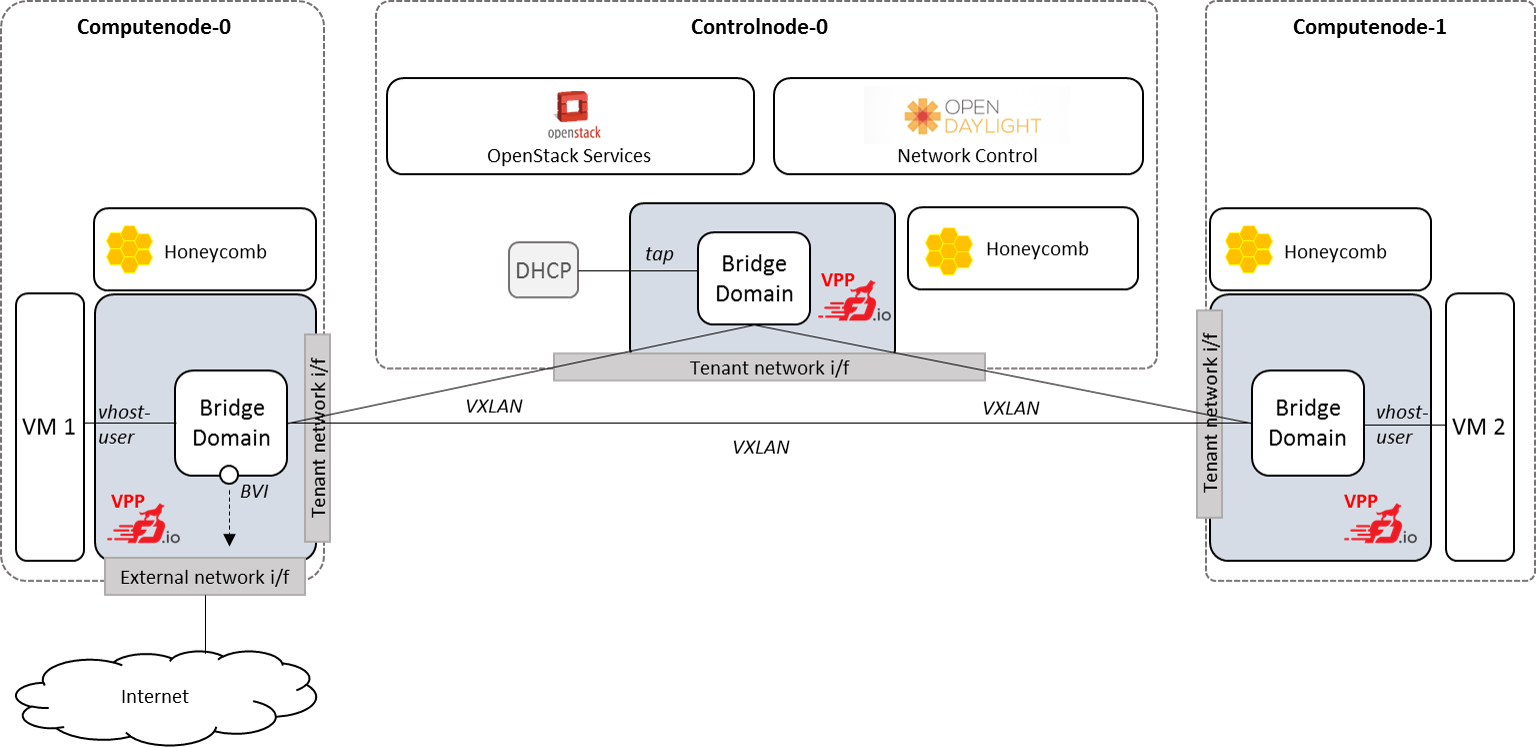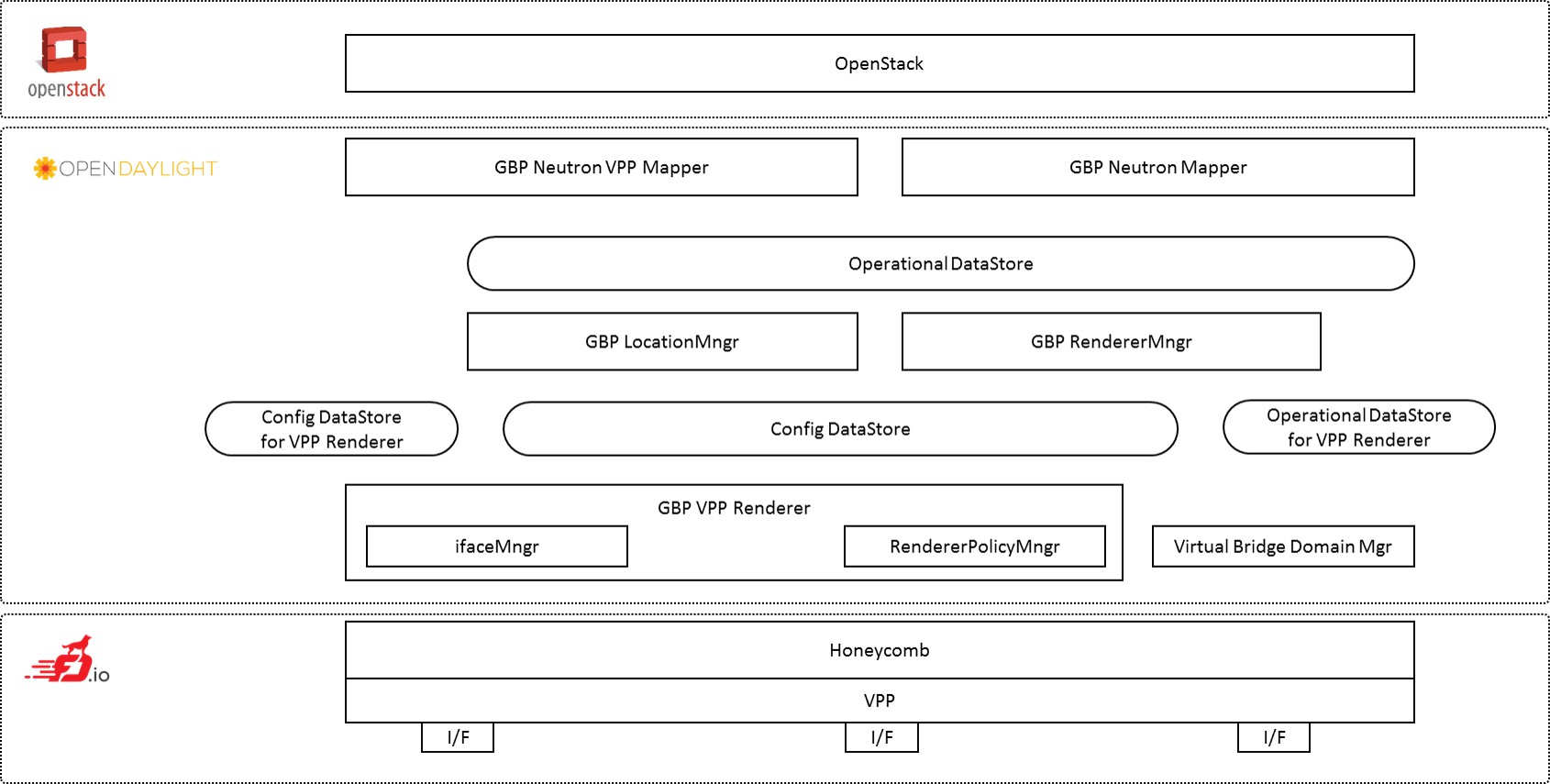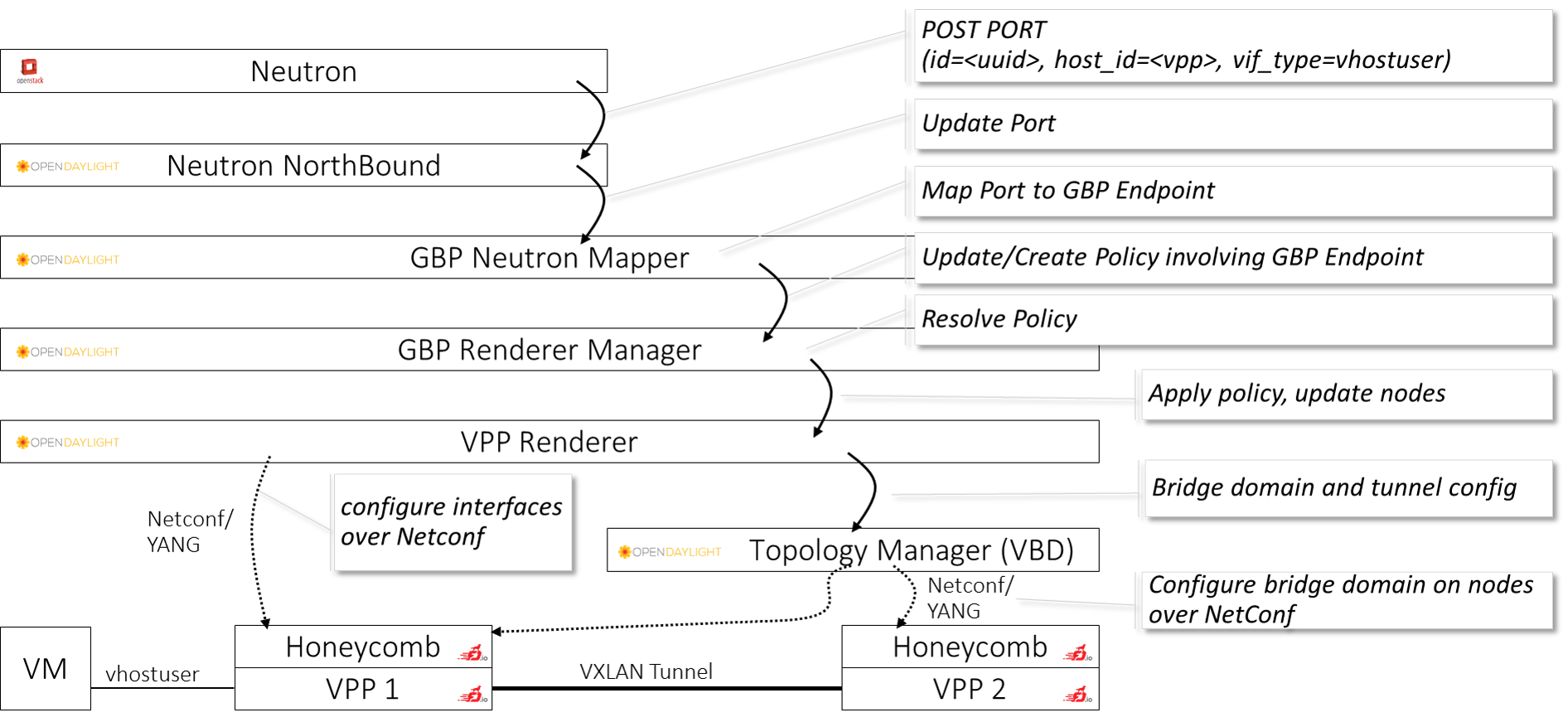Fast Data Stacks Scenario: os-odl-fdio-dvr-ha Overview and Description¶
Scenario: “OpenStack - Opendaylight - FD.io DVR” (apex-os-odl-fdio-dvr-ha) is a scenario developed as part of the FastDataStacks OPNFV project.
1. Scenario: “OpenStack - OpenDaylight - FD.io DVR”¶
Scenario: apex-os-odl-fdio-dvr-ha
“apex-os-odl-fdio-dvr-ha” is a scenario developed as part of the FastDataStacks OPNFV project. The main components of the “apex-os-odl-fdio-dvr-ha” scenario are:
- APEX (TripleO) installer (please also see APEX installer documentation)
- Openstack (in HA configuration)
- OpenDaylight controller (in cluster) controlling layer 2 and layer 3 networking
- FD.io/VPP virtual forwarder for tenant networking
2. Introduction¶
NFV and virtualized high performance applications, such as video processing, require a “fast data stack” solution that provides both carrier grade forwarding performance, scalability and open extensibility, along with functionality for realizing application policies and controlling a complex network topology.
A solution stack is only as good as its foundation. Key foundational assets for NFV infrastructure are
- The virtual forwarder: The virtual forwarder needs to be a feature rich, high performance, highly scale virtual switch-router. It needs to leverage hardware accelerators when available and run in user space. In addition, it should be modular and easily extensible.
- Forwarder diversity: A solution stack should support a variety of forwarders, hardware forwarders (physical switches and routers) as well as software forwarders. This way virtual and physical forwarding domains can be seamlessly glued together.
- Policy driven connectivity: Connectivity should respect and reflect different business
In order to meet the desired qualities of an NFV infrastructure, the following components were chosen for the “Openstack - OpenDaylight - FD.io” scenario:
- FD.io Vector Packet Processor (VPP) - a highly scalable, high performance, extensible virtual forwarder
- OpenDaylight Controller - an extensible controller platform which offers the ability to separate business logic from networking constructs, supports a diverse set of network devices (virtual and physical) via the “group based policy (GBP)” component, and can be clustered to achieve a highly available deployment.
The “Openstack - OpenDaylight - FD.io DVR” scenario provides the capability to realize a set of use-cases relevant to the deployment of NFV nodes instantiated by means of an Openstack orchestration system on FD.io/VPP enabled compute nodes. The role of the Opendaylight network controller in this integration is twofold. It provides a network device configuration and topology abstraction via the Openstack Neutron interface, while providing the capability to realize more complex network policies by means of Group Based Policies. Furthermore it also provides the capabilities to monitor as well as visualize the operation of the virtual network devices and their topologies. In supporting the general use-case of instantiatiting an NFV instance, two specific types of network transport use cases are realized:
- NFV instances with VPP data-plane forwarding using a VLAN provider network
- NFV instances with VPP data-plane forwarding using a VXLAN overlay transport network
A deployment of the “apex-os-odl-fdio-dvr-ha” scenario consists of 4 or more servers:
1 Jumphost hosting the APEX installer - running the Undercloud
- 1 Controlhost, which runs the Overcloud as well as
OpenDaylight as a network controller
- 2 or more Computehosts. These Computehosts also serve as
layer 3 gateways for tenant networks.
- TODO: update the image:
- Compute 0..N are gateways
- NIC2s on controllers are not in vpp

Tenant and public networking leverages FD.io/VPP. On compute nodes, VPP binds to both the tenant networking interface as well as the public networking interface. This means that VPP is used for communication within a tenant network, between tenant networks, as well as between a tenant network and the Internet.
Note that this setup slightly differs from the usual centralized L3 setup with qrouter on the control node. This setup was chosen to limit the configuration changes for the introduction of FD.io/VPP. The OpenDaylight network controller is used to setup and manage layer 2 and layer 3 networking for the scenario - with Group Based Policy (GBP) being the key component. Tenant networking can either leverage VXLAN (in which case a full mesh of VXLAN tunnels is created) or VLANs.
The picture below shows an example setup with two compute and one control node. Note that the external network is connected via compute node 0 through VPP. VPP provides all layer 3 services which are provided in a “vanilla” OpenStack deployment, including SNAT and DNAT, as well as north-south and east-west traffic filtering for security purposes (“security groups”).
- TODO: update the image:
- Add External network interface to Computenode-1

2.1. Features of the scenario¶
Main features of the “apex-os-odl-fdio-dvr-ha” scenario:
- Automated installation using the APEX installer
- Fast and scalable tenant networking using FD.io/VPP as forwarder
- Layer 2 networking using VLANs or VXLAN, managed and controlled through OpenDaylight
- Layer 3 connectivitiy for tenant networks supplied through FD.io/VPP. Layer 3 features, including security groups as well as floating IP addresses (i.e. NAT) are implemented by the FD.io/VPP forwarder
- Manual and automatic (via DHCP) addressing on tenant networks
3. Scenario components and composition¶
TODO: add LISP to components
The apex-os-odl-fdio-dvr-ha scenario combines components from three key open source projects: OpenStack, OpenDaylight, and Fast Data (FD.io). The key components that realize the apex-os-odl-fdio-dvr-ha scenario and which differ from a regular, OVS-based scenario, are the OpenStack ML2 OpenDaylight plugin, OpenDaylight Neutron Northbound, OpenDaylight Group Based Policy, OpenDaylight Virtual Bridge Domain Manager, FD.io Honeycomb management agent and FD.io Vector Packet Processor (VPP).
Note that the key components of the OpenDaylight based scenarios of FastDataStacks are the same. The centrallized scenario “apex-os-odl-fdio-noha” and the DVR scenario “apex-os-odl-fdio-dvr-ha” share the same components.
Here’s a more detailed list of the individual software components involved:
Openstack Neutron ML2 OpenDaylight Plugin: Handles Neutron data base synchronization and interaction with the southbound controller using a REST interface.
ODL GBP Neutron Mapper: Maps neutron elements like networks, subnets, security groups, etc. to GBP entities: Creates policy and configuration for tenants (endpoints, resolved policies, forwarding rules).
ODL GBP Neutron VPP Mapper: Maps Neutron ports to VPP endpoints in GBP.
ODL GBP Location Manager: Provides real location for endpoints (i.e. Which physical node an endpoint is connected to).
GBP Renderer Manager: Creates configuration for Renderers (like e.g. VPP-Renderer or OVS-Renderer). The GBP Renderer Manager is the central point for dispatching of data to specific device renderers. It uses the information derived from the GBP end-point and its topology entries to dispatch the task of configuration to a specific device renderer by writing a renderer policy configuration into the registered renderer’s policy store. The renderer manager also monitors, by being a data change listener on the VPP Renderer Policy States, for any errors in the application of a rendered configuration.
GBP VPP Renderer Interface Manager: Listens to VPP endpoints in the Config DataStore and configures associated interfaces on VPP via HoneyComb.
GBP VPP Renderer Renderer Policy Manager: Manages the creation of bridge domains using VBD and assigns interfaces to bridge domains.
Virtual Bridge Domain Manager (VBD): Creates bridge domains (i.e. in case of VXLAN creates full mesh of VXLAN tunnels, configures split horizon on tunnel endpoints etc.). VDB configures VXLAN tunnels always into a full-mesh with split-horizon group forwarding applied on any domain facing tunnel interface (i.e. forwarding behavior will be that used for VPLS).
Virtual Packet Processor (VPP) and Honeycomb server: The VPP is the accelerated data plane forwarding engine relying on vhost user interfaces towards Virtual Machines created by the Nova Agent. The Honeycomb NETCONF configuration server is responsible for driving the configuration of the VPP, and collecting the operational data.
Nova Agent: The Nova Agent, a sub-component of the overall Openstack architecture, is responsible for interacting with the compute node’s host Libvirt API to drive the life-cycle of Virtual Machines. It, along with the compute node software, are assumed to be capable of supporting vhost user interfaces.
The picture below shows the key components.
- TODO: update the image:
- Add LISP

To provide a better understanding how the above mentioned components interact with each other, the following diagram shows how the example of creating a vhost-user port on VPP through Openstack Neutron:
To create or update a port, Neutron will send a request to ODL Neutron Northbound which contains the UUID, along with the host-id as “vpp” and vif-type as “vhost-user”. The GBP Neutron mapper turns the “Neutron speak” of “ports” into the generic connectivity model that GroupBasedPolicy uses. Neutron “ports” become generic “GBP Endpoints” which can be consumed by the GBP Renderer Manager. The GBP Renderer Manager resolves the policy for the endpoint, i.e. it determines which communication relationships apply to the specific endpoint, and hands the resolution to a device specific renderer, which is the VPP renderer in the given case here. VPP renderer turns the generic policy into VPP specific configuration. Note that in case the policy would need to be applied to a different device, e.g. an OpenVSwitch (OVS), then an “OVS Renderer” would be used. VPP Renderer and the topology manager (“Virtual Bridge Domain” manager - i.e. VBD) cooperate to create the actual network configuration. VPP Renderer configures the interfaces to the virtual machines (VM), i.e. the vhost-user interface in the given case here and attaches them to a bridge domain on VPP. VBD handles the setup of connectivity between bridge domains on individual VPPs, i.e. it maintains the VXLAN tunnels in the given case here. Both VPP Renderer as well as VBD communicate with the device through Netconf/YANG. All compute and control nodes run an instance of VPP and the VPP-configuration agent “Honeycomb”. Honeycomb serves as a Netconf/YANG server, receives the configuration commands from VBD and VPP Renderer and drives VPP configuration using VPP’s local Java APIs.

- TODO: add description (and possibly a picture) of how forwarding works -
- describe how packets travel in the setup NOTE: could be in some different place in the document
4. Scenario Configuration¶
To enable the “apex-os-odl-fdio-dvr-ha” scenario check the appropriate settings in the APEX configuration files. Those are typically found in /etc/opnfv-apex.
File “deploy_settings.yaml”: Choose Opendaylight as controller with version “oxygen” and enable vpp as forwarder. “odl_routing_node” chooses the dvr setup for l3 forwarding:
deploy_options:
sdn_controller: opendaylight
odl_version: oxygen
odl_routing_node: dvr
tacker: true
congress: true
sfc: false
vpn: false
vpp: true
dataplane: fdio
performance:
Controller:
kernel:
hugepages: 1024
hugepagesz: 2M
intel_iommu: 'on'
iommu: pt
isolcpus: 1,2
vpp:
main-core: 1
corelist-workers: 2
uio-driver: uio_pci_generic
Compute:
kernel:
hugepagesz: 2M
hugepages: 2048
intel_iommu: 'on'
iommu: pt
isolcpus: 1,2
vpp:
main-core: 1
corelist-workers: 2
uio-driver: uio_pci_generic
5. Limitations, Issues and Workarounds¶
For specific information on limitations and issues, please refer to the APEX installer release notes.
6. References¶
- FastDataStacks OPNFV project wiki: https://wiki.opnfv.org/display/fds
- Fast Data (FD.io): https://fd.io/
- FD.io Vector Packet Processor (VPP): https://wiki.fd.io/view/VPP
- OpenDaylight Controller: https://www.opendaylight.org/
- OPNFV Danube release - more information: http://www.opnfv.org/danube
